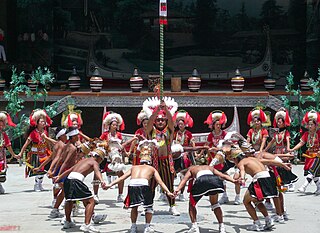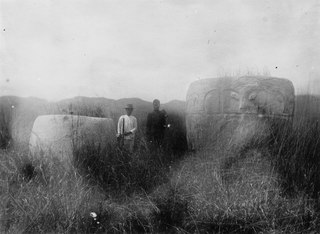Related Research Articles
Polynesians form an ethnolinguistic group of closely related people who are native to Polynesia, an expansive region of Oceania in the Pacific Ocean. They trace their early prehistoric origins to Island Southeast Asia and form part of the larger Austronesian ethnolinguistic group with an Urheimat in Taiwan. They speak the Polynesian languages, a branch of the Oceanic subfamily of the Austronesian language family.

The Lapita culture is the name given to a Neolithic Austronesian people and their material culture, who settled Island Melanesia via a seaborne migration at around 1600 to 500 BCE. They are believed to have originated from the northern Philippines, either directly, via the Mariana Islands, or both. They were notable for their distinctive geometric designs on dentate-stamped pottery, which closely resemble the pottery recovered from the Nagsabaran archaeological site in northern Luzon. The Lapita intermarried with the Papuan populations to various degrees, and are the direct ancestors of the Austronesian peoples of Polynesia, eastern Micronesia, and Island Melanesia.

Nusantara is the Indonesian name of Maritime Southeast Asia. It is an Old Javanese term which literally means "outer islands". In Indonesia, it is generally taken to mean the Indonesian Archipelago. Outside of Indonesia, the term has been adopted to refer the Malay Archipelago.

Gajah Mada, also known as Jirnnodhara was, according to Old Javanese manuscripts, poems, and inscriptions, a powerful military leader and Mahapatih of the Javanese empire of Majapahit during the 14th century. He is credited with bringing the empire to its peak of glory.

The Austronesian peoples, sometimes referred to as Austronesian-speaking peoples, are a large group of peoples in Taiwan, Maritime Southeast Asia, Micronesia, coastal New Guinea, Island Melanesia, Polynesia, and Madagascar that speak Austronesian languages. They also include indigenous ethnic minorities in Vietnam, Cambodia, Myanmar, Thailand, Hainan, the Comoros, and the Torres Strait Islands. The nations and territories predominantly populated by Austronesian-speaking peoples are sometimes known collectively as Austronesia.
In a hypothesis developed by Wilhelm Solheim, the Nusantao Maritime Trading and Communication Network (NMTCN) is a trade and communication network that first appeared in the Asia-Pacific region during its Neolithic age, or beginning roughly around 5000 BC. Nusantao is an artificial term coined by Solheim, derived from the Austronesian root words nusa "south" and tao "man, people". Solheim's theory is an alternative hypothesis to the spread of the Austronesian language family in Southeast Asia. It contrasts the more widely accepted Out-of-Taiwan hypothesis (OOT) by Peter Bellwood.

The prehistory of the Philippines covers the events prior to the written history of what is now the Philippines. The current demarcation between this period and the Early history of the Philippines is April 21, 900, which is the equivalent on the Proleptic Gregorian calendar for the date indicated on the Laguna Copperplate Inscription—the earliest known surviving written record to come from the Philippines. This period saw the immense change that took hold of the archipelago from Stone Age cultures in 50000 BC to the emergence of developed thalassocratic civilizations in the fourth century, continuing on with the gradual widening of trade until 900 and the first surviving written records.

There have been several models of early human migration to the Philippines. Since H. Otley Beyer first proposed his wave migration theory, numerous scholars have approached the question of how, when and why humans first came to the Philippines. The current scientific consensus favors the "Out of Taiwan" model, which broadly match linguistic, genetic, archaeological, and cultural evidence.
The Barito languages are around twenty Austronesian languages of Indonesia (Borneo), Southern Philippines, plus Malagasy, the national language of Madagascar. They are named after the Barito River located in South Kalimantan, Indonesia.
Peter Stafford Bellwood is Emeritus Professor of Archaeology in the School of Archaeology and Anthropology at the Australian National University (ANU) in Canberra.
Ma'anyan or Ma'anjan or Maanyak Dayak is an Austronesian language belonging to the East Barito languages. It is spoken by about 150,000 Ma'anyan people living in the province of Central Kalimantan and South Kalimantan, Indonesia. It is closely related to the Malagasy language spoken in Madagascar.

The Buni culture is a prehistoric clay pottery culture that flourished in coastal northern West Java, Jakarta and Banten around 400 BC to 100 AD and probably survived until 500 AD. The culture was named after its first discovered archaeological site, Buni village in Babelan, Bekasi, east of Jakarta.
Professor Raden Panji Soejono is an Indonesian archaeologist. He retired as director of the National Research Centre for Archaeology (ARKENAS) in 1987. Early in his career, in 1956, he served as Curator of Prehistory at the National Museum of Indonesia. He received the title of Extraordinarius Professor at the University of Indonesia and the Gadjah Mada University, and Doctor Onoris Causa at Aix-Marseille University. In 1990, he was awarded the Chevalier de l'Ordre des Arts et Lettres.
The 'Two Layer' Hypothesis, or immigration hypothesis, is an archaeological hypothese that suggests the human occupation of mainland Southeast Asia occurred over two distinct periods by two separate racial groups, hence the term 'layer'. According to the Two Layer Hypothesis, early indigenous Australo-Melanesian peoples comprised the first population of Southeast Asia before their genetic integration with a second wave of inhabitants from East Asia, including Southern China, during the agricultural expansion of the Neolithic. The majority of evidence for the Two Layer Hypothesis consists of dental and morphometric analyses from archaeological sites throughout Southeast Asia, most prominently Thailand and Vietnam.

Batu kenongs, also known as stone kenongs, is a type of megalith. They became prevalent sometime between the neolithic and early Iron Ages as megalithic culture spread to Indonesia. Archeological research of the stones began in the late 19th century, continuing to present day. There is much uncertainty in how they came to Indonesia, but they are believed to have been used to support buildings.

The Pokekea Megalithic Site is a megalithic archaeological site in the Lore Lindu National Park. It is located in the Behoa (Besoa) Valley northwest of Bada Valley. The Behoa valley is notable for its preserved kalambas, megaliths shaped like large cylindrical stone vats. The kalambas served as communal funerary urns and resemble in form and function the monuments on the Plain of Jars in Laos.

The archaeology of Indonesia is the study of the archaeology of the archipelagic realm that today forms the nation of Indonesia, stretching from prehistory through almost two millennia of documented history. The ancient Indonesian archipelago was a geographical maritime bridge between the political and cultural centers of Ancient India and Imperial China, and is notable as a part of ancient Maritime Silk Road.
Southeast Asia was first reached by anatomically modern humans in two distinct waves before 50,000 years ago, possibly firstly before 70,000 years ago. The oldest anatomically modern human fossil from Southeast Asia was found in Callao Cave, near Peñablanca, Cagayan, dated to 67,000 years old in 2010. Anatomically modern humans are suggested to have reached Southeast Asia twice in the course of the Southern Dispersal migrations during and after the formation of a distinct East Asian clade, at around 50,000 years ago.

The Toalean people were hunter-gatherers who inhabited the Indonesian island of Sulawesi during the Mid- to Late-Holocene period prior to the spread of Austronesian Neolithic farmers some 3,500 years ago from mainland Asia.
John Norman Miksic is an American-born archaeologist.
References
- ↑ Iskandar Zulkarnain (22 August 2015). "LIPI Sarwono Award 2015". Lembaga Ilmu Pengetahuan Indonesia (LIPI).
- 1 2 Widianto, Harry (2017). "Prolog: Truman Simantjuntak, Sang Peneliti Sejati". In Harry Widianto (ed.). Jejak Austronesia Di Indonesia. Yogyakarta: Gajah Mada University Presss.
- 1 2 "Harry Truman Simanjuntak". Pusat Penelitian Arkeologi Nasional. Retrieved 26 November 2022.
- 1 2 Aloysius Budi Kurniawan (27 August 2021). "Truman Simanjuntak: Arkeolog Jangan Pernah Puas Hanya di Belakang Meja" [Truman Simanjuntak: The archaeologist who is never content just to stay behind his desk]. Kompas (in Indonesian). Retrieved 26 November 2022.
- 1 2 Ratih Anbarini (20 August 2015). "Harry Truman Simanjuntak, 38 Tahun Mengabdi di Dunia Arkeologi" [Harry Truman Simanjuntak, 38 years of service in the world of archaeology] (in Indonesian). Ministry of Education and Culture. Retrieved 26 November 2022.
- ↑ Simanjuntak T (2017). "The Western Route Migration: A Second Probable Neolithic Diffusion to Indonesia" (PDF). In Piper PJ, Matsumura H, Bulbeck D (eds.). New Perspectives in Southeast Asian and Pacific Prehistory. terra australis. Vol. 45. ANU Press. pp. 201–212. doi: 10.22459/TA45.03.2017.11 . ISBN 9781760460952. JSTOR j.ctt1pwtd26.18 . Retrieved 4 November 2021.
- ↑ Hung, Hsiao-chun (2019). "History and Current Debates of Archaeology in Island Southeast Asia". In C. Smith (ed.). Encyclopedia of Global Archaeology. Cham: Springer. doi:10.1007/978-3-319-51726-1_3373-1.